Flying around the pattern with perfect coordination is more difficult than most pilots think. Its also essential to safety because this is where the majority of accidents happen either from collisions or loss of control. Aviation educators must be insistent on thorough understanding and proper control usage if we are going to make better, safer pilots.
The correct actions and control pressures required in the pattern often go against what initially seems “natural” to new trainees; their “naive rendition.” Aviation educators need to patiently unpack and overwrite naive assumptions with correct theory and control usage. These are “trained responses” and require lots of practice to become embedded, implicit scripts that are constantly ready for use by the savvy pilot. There are lots of negative transfers from our more common transportation activity; driving.
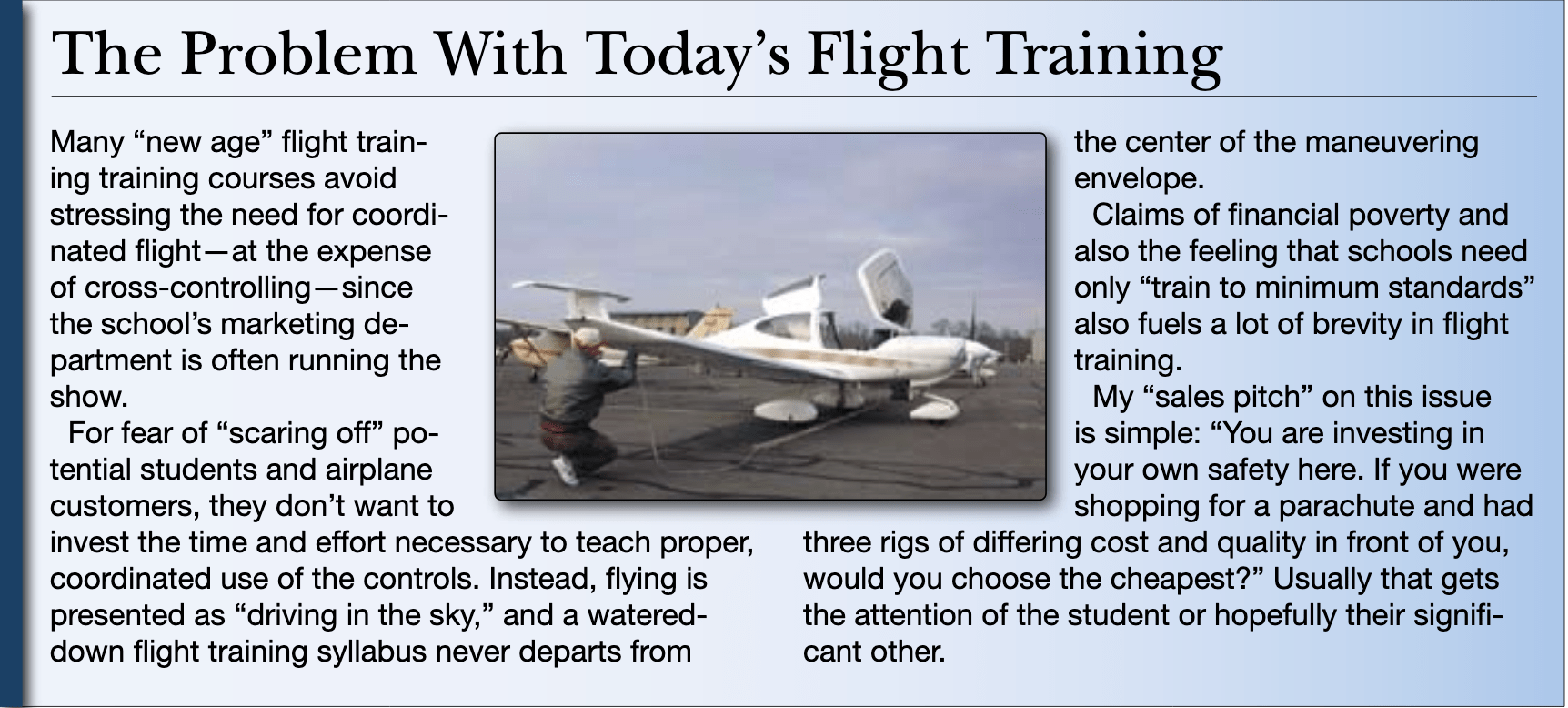
ANd every educator will get arguments that mastering the correct control application is unnecessary because what they are doing “works already” or they will correct sloppy control later; neither is true. The basics must be mastered early and practiced often in flying or you have embedded a ticking bomb in your procedures that will surface later when a critical surprise situation requires immediate and accurate control skills to save the day. Marginal performance from power loss or density altitude challenges can suddenly require us to squeeze every ounce of performance from our aircraft. For safety and efficiency we need to unpack some of these less studied effects and work to master correct coordination.
A common example of “instinctual control”is seen in new pilots on initial power application and rotating to climb for take-off. These new learners counter left yawing tendencies with aileron; a powerful negative transfer from driving. Many experienced pilots still exhibit a trace of this incorrect control input. Correctly canceling the yaw with rudder is a trained response that has to overwrite “intuition” and driving habits through continual reinforcement. With practice, the nose should rise straight and steady to a know climb attitude with outside reference and rudder pressure. As the plane leaves the ground and starts climbing, some even more subtle control pressures are necessary to stay coordinated.
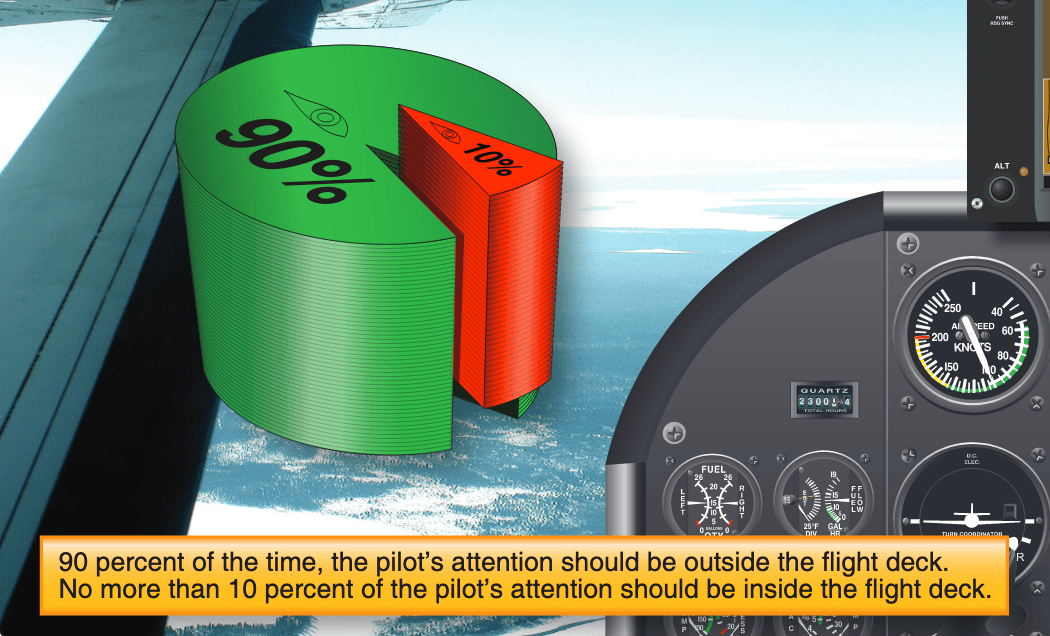 As we leave the ground, the rotation point shifts from the wheels to the CG point (forward of the wing) so a release of back pressure (lower nose) is required. Additionally, the increase of induced drag upon leaving ground effect requires additional release of back pressure. The proper climb picture required should be memorized and acquired with visual outside reference. The view outside will also allow a pilot to see that left aileron is necessary to keep the wings level in the climb. Right rudder pressure causes a proverse roll to the right (more prominent in some planes than others). This subtle force surprises even experienced pilots when it is pointed out. Climbing coordinated requires some cross control pressure to keep the ball centered and the wings level; “cross-coordinated.” In the proper configuration, most planes exhibit 15% greater climb rate when correctly coordinated on the takeoff since they are stramlined and more efficient. (Try gliders to experience how necessary proper coordination is to performance) Though 300-700 HP can pull almost anything airborne even sideways, bad coordination in emergency situations is the killer. It is amazing that 24% of fatal accidents occur on the take-off and initial climb. Many pilots just don’t value all the challenges here – “hard to miss the sky!”
As we leave the ground, the rotation point shifts from the wheels to the CG point (forward of the wing) so a release of back pressure (lower nose) is required. Additionally, the increase of induced drag upon leaving ground effect requires additional release of back pressure. The proper climb picture required should be memorized and acquired with visual outside reference. The view outside will also allow a pilot to see that left aileron is necessary to keep the wings level in the climb. Right rudder pressure causes a proverse roll to the right (more prominent in some planes than others). This subtle force surprises even experienced pilots when it is pointed out. Climbing coordinated requires some cross control pressure to keep the ball centered and the wings level; “cross-coordinated.” In the proper configuration, most planes exhibit 15% greater climb rate when correctly coordinated on the takeoff since they are stramlined and more efficient. (Try gliders to experience how necessary proper coordination is to performance) Though 300-700 HP can pull almost anything airborne even sideways, bad coordination in emergency situations is the killer. It is amazing that 24% of fatal accidents occur on the take-off and initial climb. Many pilots just don’t value all the challenges here – “hard to miss the sky!”
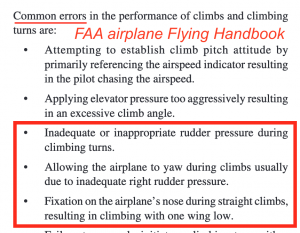 The standard left crosswind turn in the patterm is an even greater challenge to keep properly coordinated for new pilots; right rudder is required! Recent accident data indiates the climbing crosswind turn in the pattern may be even more dangerous than the well known base-to-final turn. Pilots turning left in a climb usually don’t apply the proper right rudder pressure to cancel the prominent left-turning forces since is initially “so unnatural.” As mentioned in many of these blogs, flying well requires many counter-intuitive trained actions to be safe. Remember, since both wings have equal lift in a stabilized turn, and the left-turning tendencies are still present and require right rudder – we are still climbing! Unfortunately, many pilots skid around their left climbing turns (standard right-hand patterns would be safer for control). Pilots who have tried chandelles – a more extreme climbing turn – are very familiar with the cross-coordination concept here. But even in the garden variety left crosswind climbing turn, right rudder is necessary. But why is flat-footed flying dangerous here?
The standard left crosswind turn in the patterm is an even greater challenge to keep properly coordinated for new pilots; right rudder is required! Recent accident data indiates the climbing crosswind turn in the pattern may be even more dangerous than the well known base-to-final turn. Pilots turning left in a climb usually don’t apply the proper right rudder pressure to cancel the prominent left-turning forces since is initially “so unnatural.” As mentioned in many of these blogs, flying well requires many counter-intuitive trained actions to be safe. Remember, since both wings have equal lift in a stabilized turn, and the left-turning tendencies are still present and require right rudder – we are still climbing! Unfortunately, many pilots skid around their left climbing turns (standard right-hand patterns would be safer for control). Pilots who have tried chandelles – a more extreme climbing turn – are very familiar with the cross-coordination concept here. But even in the garden variety left crosswind climbing turn, right rudder is necessary. But why is flat-footed flying dangerous here?
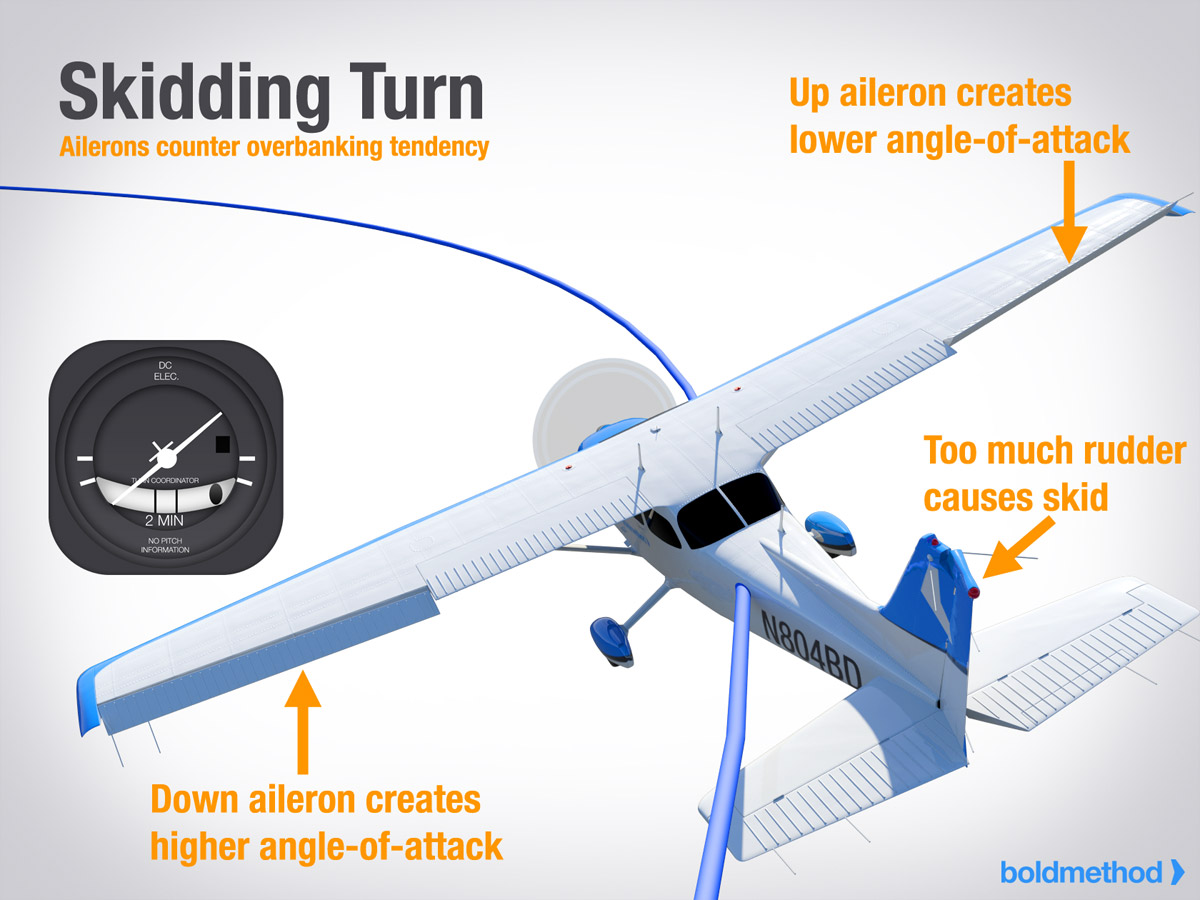 In skidding turns, the force of roll and yaw are both acting in the same downward direction; they are coupled and adverse in effect – pro-spin. And when pilots inappropriately counter this skid in a climbing left turn with more aileron, this incorrect control application increases the angle of attack on the lower, slower wing making it more apt to stall first and spin. This illustration from Bold Method provides a depiction of the many problems with a skid. Correct control application must be taught relentlessly by a committed aviation educator and studied carefully by the pilot in training to become an embedded habit. And this habit is harder to master since it is a kearned action that is initially completely counter-intuitive. Anything less is unsafe.
In skidding turns, the force of roll and yaw are both acting in the same downward direction; they are coupled and adverse in effect – pro-spin. And when pilots inappropriately counter this skid in a climbing left turn with more aileron, this incorrect control application increases the angle of attack on the lower, slower wing making it more apt to stall first and spin. This illustration from Bold Method provides a depiction of the many problems with a skid. Correct control application must be taught relentlessly by a committed aviation educator and studied carefully by the pilot in training to become an embedded habit. And this habit is harder to master since it is a kearned action that is initially completely counter-intuitive. Anything less is unsafe.
The skidding turn seems to be always depicted in a nose low, base-to-final turn in the pattern where the pilot induces the skid with rudder. But you will see far more skidding turns in a climb if you pay attention since this is where all the powerful left-turning tendencies are at work creating the skid. These forces must be actively countered with rudder to prevent a skid. This tendency is especially common in bigger planes and more powerful engines in the climbing turns. Do the math and you can discern that this is often demonstrated by the “captain of industry” – an affluent step-up client who bought a big new plane. This person is already a “trained pilot” but often needs remedial instruction to be safe. The professional aviation educator must be firm here to address and fix these coordination problems. Acquiescing to poor control or bad technique is unprofessional and unsafe; it’s how we are losing control in our aircraft every day. Fly safe out there (and often)!
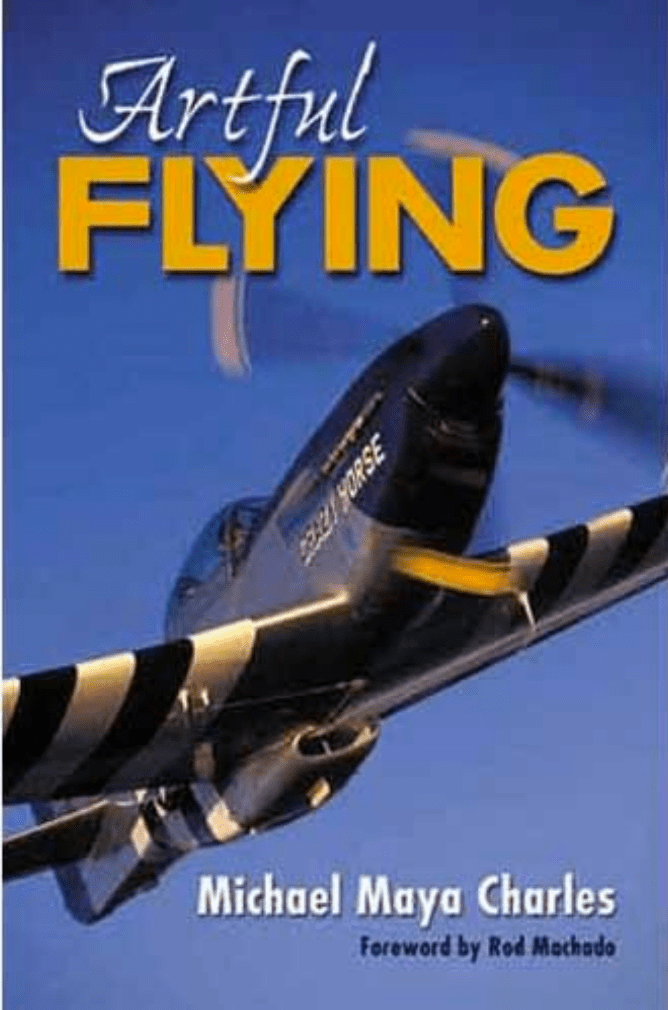 An appreciative nod to Michael Maya Charles and his amazing book “Artful Flying” which continues to inspire me daily. Flying well is more than a just being safe.It is a daily joy to pursue excellence in aviation; flying artfully!
An appreciative nod to Michael Maya Charles and his amazing book “Artful Flying” which continues to inspire me daily. Flying well is more than a just being safe.It is a daily joy to pursue excellence in aviation; flying artfully!

Join SAFE to support our safety mission of generating aviation excellence in teaching and flying. Our amazing member benefits pay back your contribution (like 1/3 off your annual ForeFlight subscription)! Our FREE SAFE Toolkit App puts required pilot endorsements and experience requirements right on your smartphone and facilitates CFI+DPE teamwork. Our CFI insurance was developed specifically for CFI professionals (and is the best value in the business).
